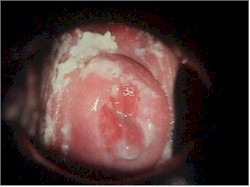
|
|
While it is often possible to correctly guess the cause of a vaginal discharge, based on history and/or physical exam, it is sometimes useful to use laboratory skills to confirm a clinical impression.
Use a wooden spatula or cotton-tipped applicator to directly obtain a sample of the discharge. You can also find abundant discharge on the inside curve of the speculum after you remove it.
Put a Tiny Amount of Discharge on a Microscope Slide
Make this as small as possible. Later, when you view it under the microscope, it will be spread as thin as a single cell. If you start off with too much discharge, it will make it harder for you to see the individual structures you need to evaluate.
Add one drop of Normal Saline (0.9 percent NaCl) to the drop of discharge. Mix well on the slide. This is the slide you will use for identifying Trichomonas and bacterial vaginosis (BV).
Prepare a second slide in the same way, using 10 percent Potassium Hydroxide (KOH). This is the slide you will use to identify yeast.
Some people find it convenient to use only a single slide, with KOH at one end and NaCl at the other end.
Place glass coverslips over the glass slides. Remove any excess fluid with tissue paper.
In order for the KOH to be effective in dissolving the cell membranes of everything except yeast, you need to allow some time. A minute or two may be enough.
If you are in a hurry, you can speed the process by heating the slide with a match or lighter. The elevated temperatures will speed the dissolving process and the glass slide cools quickly enough that you can place it under the microscope as soon as you've finished heating it.
Examine the prepared slides under a microscope.
Experienced practitioners often find the lowest power (about 40X) works the best. Others will start at low power and then move to slightly higher power (about 100X).
The magnification is determined by multiplying the power of the eyepiece (typically 10X) by the power of the objective lens (4X, 10X, 40X, 80X) to get the various possible total magnifications (40X, 100X, 400X, and 800X in this example.)

Yeast (Candida, Monilia) is best identified with the KOH slide.
After the cell membranes are dissolved, the typical branching and budding yeast cells can be seen. Sometimes, it has the appearance of a tangled web of threads. At other times, only small branches will be seen.
Yeast normally live in the vagina, but only in very small numbers. If you visualize any yeast in your sample, it is considered significant.
Trichomonas is best seen on the Normal Saline slide.
These protozoans are about the same size as a white blood cell (a little smaller than a vaginal epithelial cell), but their violent motion is striking and unmistakable.
Bacterial vaginosis (also known as Gardnerella, hemophilus, or non-specific vaginitis) is characterized by the presence of "clue cells" visible at both low and medium power.
These clue cells are vaginal epithelial cells studded with bacteria. It resembles a pancake that has fallen into a bowl of poppy seeds, but on a microscopic level.
A normal vaginal epithelial cell is clear, with recognizable contents, and sharp, distinct cell borders.
A clue cell appears smudged, with indistinct contents and fuzzy, poorly defined borders.
Bureau of Medicine and
Surgery |
Operational Obstetrics
& Gynecology - 2nd Edition |